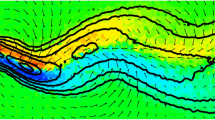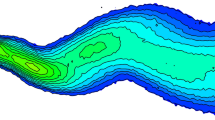Abstract
We present an experimental study of the dynamics of a plume generated from a small heat source in a high Prandtl number fluid with a strongly temperature-dependent viscosity. The velocity field was determined with particle image velocimetry, while the temperature field was measured using differential interferometry and thermochromic liquid crystals. The combination of these different techniques run simultaneously allows us to identify the different stages of plume development, and to compare the positions of key-features of the velocity field (centers of rotation, maximum vorticity locations, stagnation points) respective to the plume thermal anomaly, for Prandtl numbers greater than 103. We further show that the thermal structure of the plume stem is well predicted by the constant viscosity model of Batchelor (Q J R Met Soc 80: 339–358, 1954) for viscosity ratios up to 50.
















Similar content being viewed by others

References
Batchelor GK (1954) Heat convection and buoyancy effects in fluids. Q J R Met Soc 80: 339–358
Boxman RL, Shlien DJ (1978) Interferometric measurement technique for the temperature field of axisymmetric buoyant phenomena. Appl Opt 17: 2788–2793
Chay A, Shlien DJ (1986) Scalar field measurements of a laminar starting plume cap using digital processing of interferograms. Phys Fluids 29: 2358–2366
Couliette DL, Loper DE (1995) Experimental, numerical and analytical models of mantle starting plumes. Phys Earth Planet Inter 92: 143–167
Dabiri D, Gharib M (1991) Digital particle image thermometry: the method and implementation. Exp Fluids 11: 77–86
Dabiri D (2009) Digital liquid crystal particle thermometry/velocimetry (DLCPT/V)—a review. Exp Fluids 46(2): 191–241
Davaille A, Jaupart C (1993) Transient high-Rayleigh number thermal convection with large viscosity variations. J Fluid Mech 253: 141–166
Davaille A, Vatteville J (2005) On the transient nature of mantle plumes. Geophys Res Lett 32: L14309 doi:10.1029/2005GL023029
Davaille A, Limare A (2007) Laboratory studies on mantle convection. In: Bercovici D, Schubert G (eds) Treatise of geophysics. Elsevier, Amsterdam, pp 89–165
Davaille A, Androvandi S, Vatteville J, Limare A, Vidal V, Lebars M (2008) Thermal boundary layer instabilities in viscous fluids. In: ISFV13—13th International symposium on flow visualization, July 1–4, 2008, Nice, France, p 12, available at http://www.ipgp.fr/~limare/317.pdf
Fuji T (1963) Theory of the steady laminar natural convection above a horizontal line heat source and a point heat source. Int J Heat Mass Transf 6: 597–606
Fujisawa N, Adrian R (1999) Three-dimensional temperature measurement in turbulent thermal convection by extended range scanning liquid crystal thermometry. J Vis 1: 355–364
Gebhart B, Pera L, Schorr WA (1970) Steady laminar natural convection plumes above a horizontal line heat source. Int J Heat Mass Tranf 13: 161–171
Griffiths RW (1986) Thermals in extremely viscous fluids, including the effects of temperature dependent viscosity. J Fluid Mech 166: 115–138
Griffiths RW, Campbell IH (1990) Stirring and structure in mantle starting plumes. Earth Planet Sci Lett 99: 66–78
Happel J, Brenner H (1973) Low Reynolds number hydrodynamics. Noordhoff, Leyden
Kaminski E, Jaupart C (2003) Laminar starting plumes in high-Prandtl-number fluids. J Fluid Mech 478: 287–298
Kumagai I (2002) On the anatomy of mantle plumes: effect of the viscosity ratio on entrainment and stirring. Earth Planet Sci Lett 198: 211–224
Kumagai I, Davaille A, Kurita K (2007) On the fate of thermal plumes at density interface, earth planet. Sci Lett 254: 180–193
Kumagai I, Davaille A, Kurita K, Stutzmann E (2008) Mantle plumes: thin, fat, successful, or failing? Constraints to explain hot spot volcanism through time and space, Geophys. Res Lett 35: L16301 http://www.dx.doi.org/10.1029/2008GL035079
Kelley JG, Hargreaves RA (1970) A rugged inexpensive shearing interferometer Appl Opt 9: 948–952
Laudenbach N, Christensen UR (2001) An optical method for measuring temperature in laboratory models of mantle plumes. Geophys J Int 145: 528–534
Le Bars M, Davaille A (2002) Stability of thermal convection in two superimposed miscible viscous fluids. J Fluid Mech 471: 339–363
Limare A, Kumagai I, Vatteville J, Davaille A (2008) Thermal plumes visualisation: differential interferometry versus thermochromic liquid crystals, ISFV13—13th international symposium on flow visualization, July 1–4, 2008, Nice, France, p 12, available at http://www.ipgp.fr/~limare/318.pdf
Morris S, Canright DR (1984) A boundary-layer analysis of Benard convection with strongly temperature-dependent viscosity. Phys Earth Planet Inter 36: 355–373
Morton BR, Taylor GI, Turner JS (1956) Turbulent gravitational convection from maintained and instantaneous sources. Proc R Soc Lond A 234:1–23
Moses E, Zocchi G, Libchaber A (1993) An experimental study of laminar plumes. J Fluid Mech 251: 581–601
Olson P, Singer H (1985) Creeping plumes. J Fluid Mech 158: 511–531
Olson P, Schubert G, Anderson C (1993) Structure of axisymmetric plumes. J Geophys Res 98: 6829–6844
Pretzler G, Jäger H, Neger T (1993) High-accuracy differential interferometry for the investigation of phase objects. Meas Sci Technol 4: 649–658
Rhee H, Koseff J, Street R (1984) Flow visualization of a recirculating flow by rheoscopic and liquid crystal techniques. Exp Fluids 2: 57–64
Rogers MC, Morris SW (2009) Natural versus forced convection in laminar starting plumes. Phys Fluids 21: 083601
Sernas V, Fletcher LS (1970) A schlieren interferometer method for heat transfer studies. J Heat Transf 92: 202–204
Shlien DJ (1976) Some laminar thermal and plume experiments. Phys Fluids 19: 1089–1098
Shlien DJ, Boxman RL (1979) Temperature field measurement of an axisymmetric laminar plume. Phys Fluids 22(4): 631–634
Shlien DJ, Brosh A (1979) Velocity field measurements of a laminar thermal. Phys Fluids 22: 1044–1053
Shlien DJ, Boxman RL (1981) Laminar starting plume temperature field measurement. Intl J Heat Mass Transf 24: 919–930
Tanny J, Shlien DJ (1985) Velocity field measurements of a laminar starting plume. Phys Fluids 28: 1027–1032
Turner JS (1962) The starting plume in neutral surroundings. J Fluid Mech 13:356–368
van Keken PE (1997) Evolution of starting mantle plumes: a comparison between laboratory and numerical models. Earth Planet Sci Lett 148: 1–14
van Keken P, King S, Schmeling H, Christensen U, Neumeister D, Doin M-P (1997) A comparison of methods for the modeling of thermochemical convection. J Geophys Res 102(B10): 22477–22495
Vasquez PA, Perez AT, Castellanos A (1996) Thermal and electrohydrodynamics plumes. A comparative study. Phys Fluids 8: 2091–2096
Vatteville J, van Keken P, Limare A, Davaille A (2009) Starting laminar plumes: comparison of laboratory and numerical modeling. Geochem Geophys Geosyst 10: Q12013 doi:10.1029/2009GC002739
Vest CM (1975) Interferometry of strongly refracting axisymmetric phase objects. Appl Opt 14: 1601–1606
Whitehead JA, Luther DS (1975) Dynamics of laboratory diapir and plume models. J Geophys Res 80: 705–717
Whittaker RJ, Lister JR (2006a) Steady axisymmetric creeping plumes above a planar boundary. Part I: a point source. J Fluid Mech 567: 361–378
Whittaker RJ, Lister JR (2006b) Steady axisymmetric creeping plumes above a planar boundary. Part II: a distributed source. J Fluid Mech 567: 379–397
Whittaker RJ, Lister JR (2008) The self-similar rise of a buoyant thermal in very viscous flow. J Fluid Mech 606: 295–324
Willert C, Gharib M (1991) Digital particle image thermometry. Exp Fluids 10: 181–193
Worster MG (1986) The axisymmetric laminar plumes: asymptotic solution for large Prandtl number. Stud Appl Math 75: 139–152
Acknowledgments
This work has benefited from discussions with Neil Ribe, Eric Mittelsteadt, Peter van Keken, and Béatrice Guerrier. It was funded by program DyETI of INSU/CNRS, the French ANR “BEGDY” and the collaboration between IPGP in Paris and ERI in Tokyo. The manuscript has been improved, thanks to the constructive comments of two anonymous reviewers.
Author information
Authors and Affiliations
Corresponding author
Electronic supplementary material
Below is the link to the electronic supplementary material.
Movie 1: RUN1. On the left side of the screen is the left half of the plume seen by differential interferometry, and on the right side is the other half of the plume followed by the thermochromic liquid crystals isotherms. The total duration of the movie is 600 s (1782 KB)
348_2010_924_MOESM2_ESM.mp4
Movie 2: RUN2. On the left side of the screen, the whole plume is imaged by its thermochromic liquid crystals isotherms, while on the right side, the plume head is followed by differential interferometry. The duration of the movie is 940 s. (1693 KB)
Appendices
Appendix 1: Viscosity laws
The fluid viscosity was measured between 15 and 65°C using a rheometer RS600 from ThermoRheo with a cylindrical geometry. We obtained for fluid 1 (RUN 1 and 2):
and for fluid 2 (RUN 3 and 4):
where T is the temperature in °C.
Appendix 2: TLC calibration
The TLCs were calibrated by imposing a stable linear temperature gradient to a 10 cm layer of the experimental fluid: the light intensity across a vertical cross-section of the tank is then plotted as a function of the vertical profile of temperature (Fig. 17). Each type of TLC results in an intensity peak for a given temperature. Each bright stripe has a finite thickness because the polymeric capsules enclosing the TLCs introduce some scatter around the temperature at which they respond. The peak maximum gives us the isotherm value; and the width of the peak at half maximum intensity (or bandwidth) gives the local temperature gradient (Table 3). Peaks are well defined for aqueous slurries in sugar syrups, where the precision of the isotherms values reaches ±0.1°C, and the bandwidth is about 0.2°C. The use of the same TLC technique in silicone oils of similar viscosity show much poorer results with bandwidth reaching 1.5°C (Limare et al. 2008; Vatteville et al. 2009). This may be due to the response of the TLCs coating, which is chemically different in the two cases.
Appendix 3: Estimate of the optical distortion
Since a thermal anomaly acts as a divergent lens, we estimated its effect on the TLC isotherms positions. For this purpose we have used the formula given by Laudenbach and Christensen (2001) for the deflection angle of a laser beam through an axisymmetric thermal plume for a given distribution of the refractive index:
where p is defined as p = r n(r) and p 0 = r n 0; and n(r) is the refractive index distribution and n 0 the refractive index of the medium at ambient temperature.
The distribution of the refractive index of the plume is known from the DI results. Since the isotherms are visualized in a plane passing through the center of the plume, we therefore considered that the deflection angle of the scattered light from the isotherms was equal to half of the total deflection angle of a virtual beam passing through the entire plume. In our case, this angle remains smaller than 10−3 radian. This implies that the associated shift in location of a given isotherm would remain smaller than 5 × 10−2 mm (Fig. 18).
Rights and permissions
About this article
Cite this article
Davaille, A., Limare, A., Touitou, F. et al. Anatomy of a laminar starting thermal plume at high Prandtl number. Exp Fluids 50, 285–300 (2011). https://doi.org/10.1007/s00348-010-0924-y
Received:
Revised:
Accepted:
Published:
Issue Date:
DOI: https://doi.org/10.1007/s00348-010-0924-y





